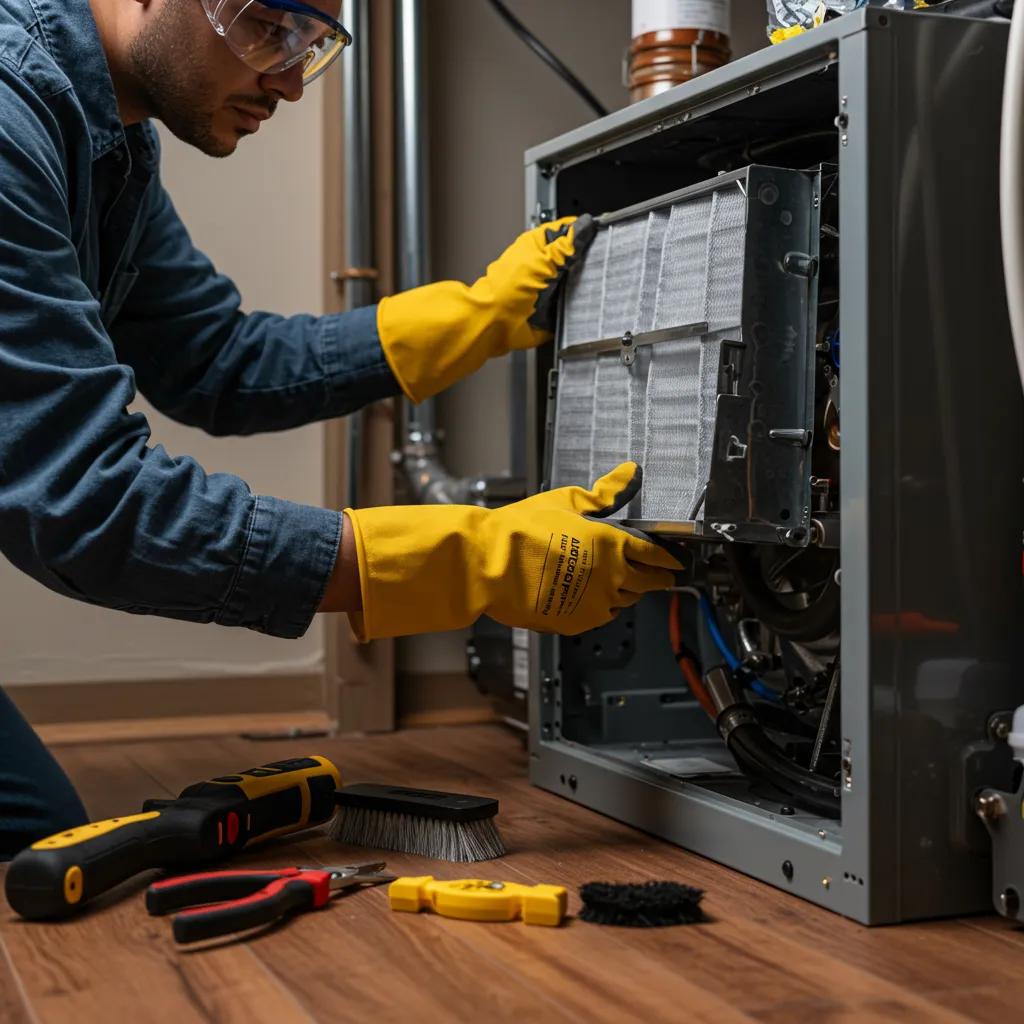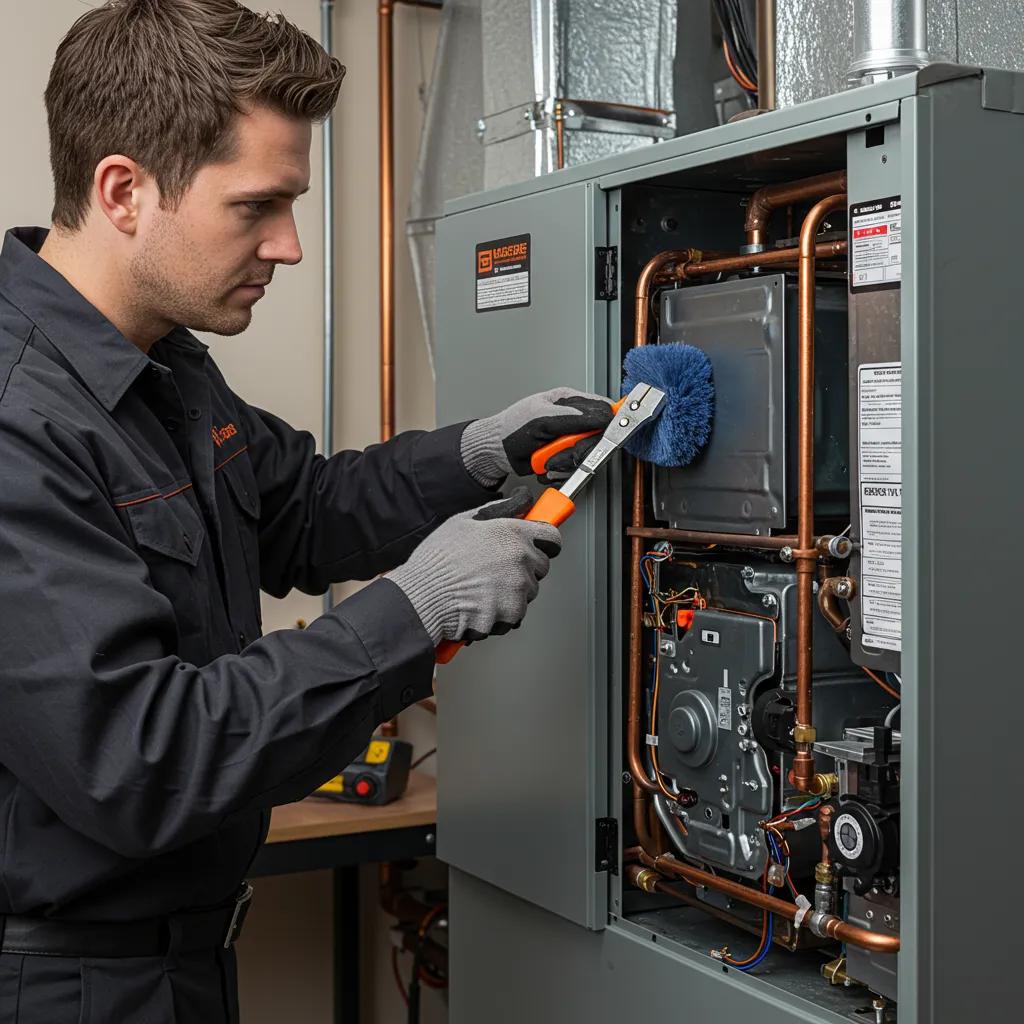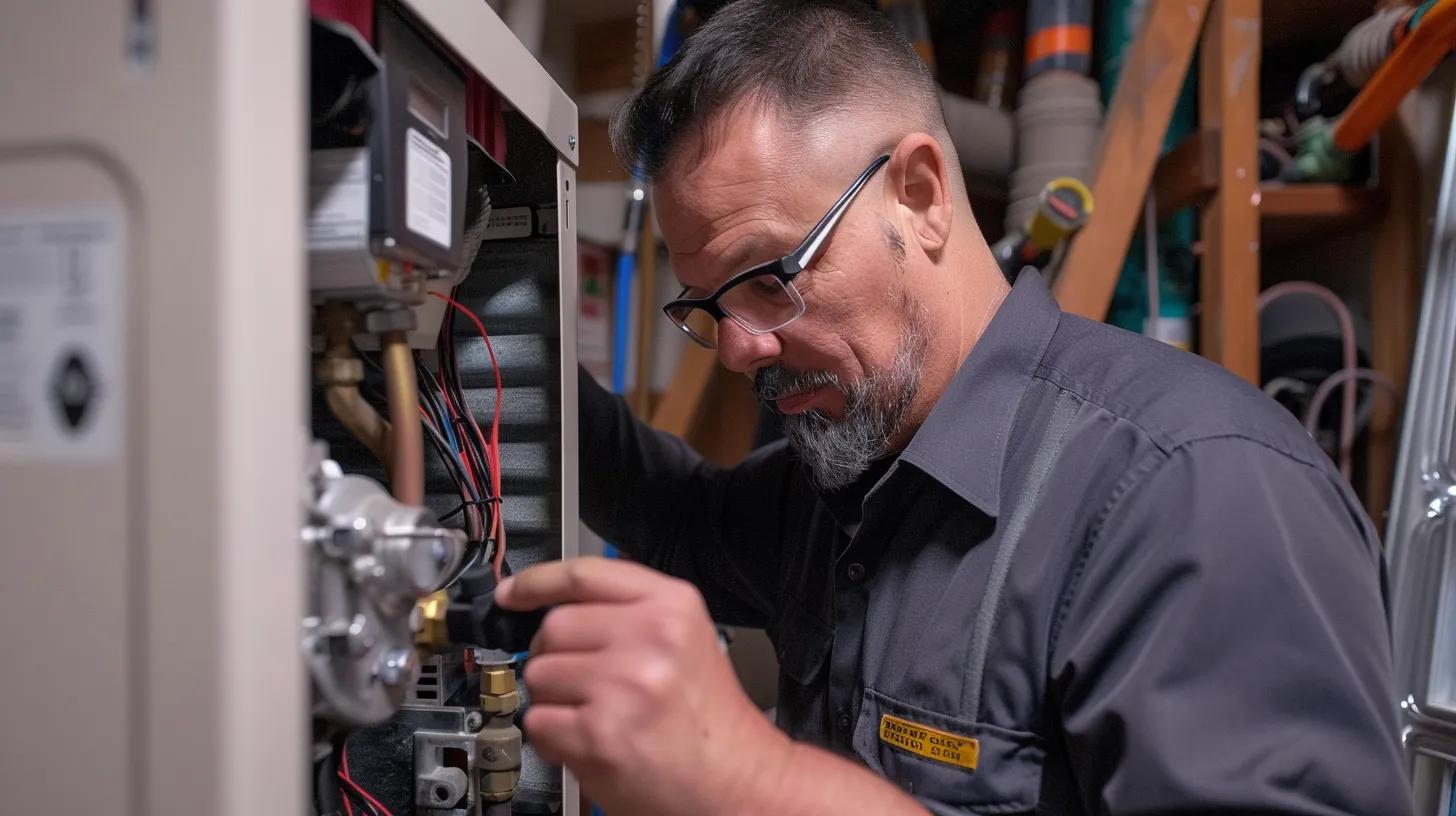Keep Your Furnace Running Smoothly: Essential Cleaning & Maintenance Tips from Mega A/C Cooling & Heating
A clean furnace isn’t just about keeping your home warm; it’s crucial for maintaining healthy indoor air and preventing dangerous carbon monoxide leaks. This guide from Mega A/C Cooling & Heating covers everything you need to know, from simple DIY tasks to when you should call in the pros. We’ll help you spot the signs of a dirty furnace, tackle basic maintenance, understand what professional cleaning involves, figure out how often you need it, and enjoy the long-term perks. By following these tips, you’ll boost your furnace’s efficiency, make it last longer, and ensure a safer, more comfortable environment for your home or business in Richmond, Sugar Land, Missouri City, TX, and nearby areas.
What Are the Key Signs Your Furnace Needs Cleaning?
How Can You Identify a Yellow or Flickering Furnace Flame?
A yellow or flickering flame is a red flag indicating incomplete combustion. This can lead to dangerous carbon monoxide production and soot buildup. When dust or debris clogs the burners, the flame’s color and stability can change. If your furnace flame shifts from its usual blue to yellow, it’s a sign that the filter might be blocked or the burners need attention – a clear signal for urgent maintenance to prevent safety risks and inefficiency.
What Do Strange Noises from Your Furnace Mean?
Rattling, popping, or booming sounds coming from your furnace often point to loose parts, dust igniting, or stress on the heat exchanger. Loose panels or debris in the blower fan can vibrate, creating rattles as the system starts up. Popping noises can happen when accumulated dust burns off during ignition, causing pressure shifts in the combustion chamber. Addressing these sounds early is key to preserving your furnace’s components and avoiding bigger problems down the road.
How Does a Dirty Furnace Affect Your Energy Bills and Heating Efficiency?
When your furnace is dirty, the blower motor has to work harder to push air through restricted pathways, which drives up energy consumption and your utility bills. Dust-clogged filters and coated heat exchangers reduce how effectively heat is transferred, forcing your furnace to run longer and leading to uneven heating. For instance, neglecting your furnace filter can result in heating bills that are up to 20 percent higher during the coldest months. Regular cleaning restores proper airflow and heat exchange, directly cutting down on energy costs.
What Are the Visible Signs of Soot and Dust Buildup on Your Furnace?
You might see black or brown residue, known as soot, around the burners and flue pipes. Dust, on the other hand, tends to accumulate on vents, air returns, and access panels. These signs indicate that combustion byproducts are building up, often due to poor filtration. For example, a visible layer of fine dust on your return-air grilles usually means there’s also dust inside the furnace cabinet on the blower blades. Removing this soot and dust not only improves your indoor air quality but also helps prevent potential ignition hazards.
When Should You Consider Professional Furnace Cleaning?
It’s time to call in the professionals when dust and soot have reached areas beyond easy access, when your heat exchanger needs a thorough inspection, or if your carbon monoxide detectors start alarming. Our certified technicians use specialized equipment to clean burners, check the heat exchanger for any cracks, and test all safety controls. If you have pets, family members with allergies, or a commercial property with heavy usage, expert service is highly recommended to keep your system running at its best. Scheduling an annual professional cleaning before the heating season kicks in is the best way to ensure safe and efficient operation all winter long.
What Are the Basic DIY Furnace Cleaning and Maintenance Tasks You Can Do Safely?

How to Replace and Clean Your Furnace Air Filter Properly?
Your furnace’s air filter is designed to catch dust, pet dander, and allergens, preventing them from circulating through your home and damaging the system. Replacing or cleaning your filter every three months is essential for maintaining good airflow and indoor air quality. To do it yourself, first turn off the power to your furnace, then carefully slide out the old filter. Check for dirt buildup and replace it with a new one that matches the correct MERV rating. Keeping your filter clean is a simple yet effective way to extend your furnace’s life and reduce dust throughout your home.
What Is the Best Way to Clear the Area Around Your Furnace?
It’s important to keep a clear space of at least two meters around your furnace. This prevents flammable materials from accidentally igniting and ensures unrestricted airflow to the unit. Make sure to store items like paint cans, cardboard boxes, or flammable liquids far away from the furnace cabinet. Regularly sweeping the floor around the furnace and removing any debris will also help prevent dust from being drawn into the blower assembly. Maintaining this clear zone is crucial for safe operation and efficient heat distribution.
How Do You Clean Furnace Vents and Air Returns?
Dust and pet hair can easily accumulate in your supply vents and air returns, not only restricting airflow but also circulating allergens into your living spaces. Start by vacuuming the vent covers and grilles using a soft brush attachment, then wipe down the surfaces with a damp cloth. For a more thorough cleaning, you can remove the vent covers and use a flexible duct brush to dislodge dust from the first meter of the ductwork. Keeping your vents and returns clean helps maintain balanced airflow and reduces the strain on your furnace.
How to Adjust and Clean Your Thermostat for Optimal Furnace Performance?
A thermostat that’s properly calibrated is key to accurate temperature control and efficient furnace operation. Gently remove the thermostat cover and dust any internal components. Check the wiring to ensure all connections are secure. If you notice the temperature reading is off by more than one degree, follow the manufacturer’s instructions to recalibrate it, or consider replacing the unit if it’s older. A clean, accurate thermostat prevents your furnace from cycling on and off too frequently and helps maintain consistent comfort in your home.
What Are the Safety Precautions When Performing DIY Furnace Cleaning?
Attempting DIY furnace cleaning without proper precautions can lead to risks like electrical shock, gas leaks, or carbon monoxide exposure. Always remember to turn off the power to your furnace at the breaker and shut off the gas supply before opening the furnace cabinet. Wear protective gear, including gloves, safety glasses, and a dust mask, especially when handling filters, removing panels, or vacuuming debris. If you notice any rust, corrosion, or complex mechanical issues, stop your DIY efforts immediately and contact a professional technician to avoid causing further damage or risking injury.
Why Is Professional Furnace Cleaning Important and What Does It Include?
What Are the Steps in Mega A/C Cooling & Heating’s Professional Furnace Cleaning Process?

When our certified technicians at Mega A/C Cooling & Heating perform a professional furnace cleaning, they start with a comprehensive inspection of your entire heating system, testing all safety controls and measuring combustion efficiency. They then carefully disassemble the burners, vacuum out soot from the combustion chamber, clean the blower assembly, and flush condensate lines if needed. Next, they meticulously inspect the heat exchanger for any signs of cracks, lubricate all moving parts, and replace any components that show wear. Finally, a performance test confirms that airflow is restored, combustion is safe, and efficiency is optimized before the system is put back into service.
How Does Professional Cleaning Improve Indoor Air Quality and Energy Efficiency?
Professional cleaning goes deep to remove microscopic dust and combustion byproducts that can compromise your indoor air quality and coat your furnace’s internal components. Our technicians clear away particles from the heat exchanger surfaces and ductwork, restoring maximum heat transfer and reducing the workload on your blower. As a result, you’ll often notice fresher air in your home and can see heating costs drop by up to 15 percent. By eliminating these hidden contaminants, professional cleaning ensures smoother operation and a healthier living environment.
What Furnace Components Require Expert Cleaning and Inspection?
Key components that absolutely need professional attention include the burners, flame sensor, heat exchanger, blower motor, and control boards. Burners must be cleaned precisely to maintain the correct fuel-air mixture and prevent soot buildup. Inspecting the heat exchanger is vital to catch hairline cracks that could potentially leak carbon monoxide. Our technicians also verify electrical connections, safety switches, and the integrity of the flue to guarantee reliable and hazard-free performance.
How Does Professional Service Prevent Carbon Monoxide Risks and Fire Hazards?
Carbon monoxide is produced when combustion isn’t complete, often due to clogged burners or damaged heat exchangers. Expert cleaning ensures your burners are operating correctly, removes heat-trapping soot, and verifies that your venting system is allowing proper flue flow. We also check safety switches and gas pressure to eliminate any inconsistencies that could lead to ignition issues. These thorough measures significantly reduce the risk of CO leaks and fire hazards, keeping your family and business safe.
Preventing Carbon Monoxide Poisoning: The Importance of Annual Furnace Inspections
Residential poisonings caused by faulty furnaces are the most common type of CO exposure. However, these poisonings are largely preventable with annual furnace inspections and CO alarm installation. Objective: This study aimed to identify the knowledge, attitudes and beliefs that might lead consumers to adopt these protective behaviours. Methods: In August 2009, four focus groups (n=29) were conducted with homeowners in Chicago, Illinois, USA, to identify the knowledge, attitudes and beliefs that lead consumers to adopt risk and protective behaviours. Discussions were transcribed and the findings were analysed using an ordered meta-matrix. Results: Focus group participants were aware of CO poisoning and supported the idea of regular furnace inspections. However, few participants consistently scheduled professional inspections for fear of costly repairs.
Risk and protective behaviours for residential carbon monoxide poisoning, JA Poehlman, 2013
How to Schedule a Professional Furnace Cleaning Service with Mega A/C Cooling & Heating?
To schedule your furnace cleaning or system maintenance in Richmond, Sugar Land, or Missouri City, simply reach out to Mega A/C Cooling & Heating’s service department for a free estimate and to book your appointment. Our technicians are available 24/7 for emergency heating repairs and seasonal tune-ups, and we stand by our transparent pricing and customer satisfaction guarantees. Booking your service before the busy winter season ensures you get timely attention and uninterrupted comfort. Let our licensed experts provide professional care to maximize your system’s safety, efficiency, and lifespan.
How Often Should You Clean Your Furnace and What Is the Typical HVAC Cleaning Cost?
What Is the Recommended Furnace Cleaning Frequency for Homes and Commercial Properties?
We strongly recommend a professional furnace cleaning once a year, ideally before the heating season begins, to keep your system running efficiently and safely. If your home has pets, significant allergy triggers, or experiences heavy usage, you might benefit from semi-annual maintenance to manage dust and allergens more effectively. For commercial properties with continuous operation, quarterly inspections and cleanings are often necessary to prevent costly downtime. Sticking to these schedules ensures reliable heating and minimizes unexpected breakdowns.
How Do Pets, Allergies, and Environmental Factors Affect Cleaning Frequency?
Pets shed dander that can quickly clog filters and coat furnace components, leading to a faster loss of efficiency and increased circulation of allergens. For individuals with allergies, more frequent filter changes and occasional duct surface cleaning are essential for maintaining healthy air quality. Properties located in dusty areas or near construction sites will also accumulate debris more rapidly, requiring extra attention. Adjusting your maintenance schedule to account for these factors is key to preserving indoor air quality and extending your equipment’s life.
What Are the Average Costs of Furnace Cleaning Services in Richmond, Sugar Land, and Missouri City, TX?
The cost of professional furnace repair can vary depending on the complexity of your system and your specific location, but our rates are competitive within the market. Our basic cleaning packages typically include a thorough inspection, filter replacement, and a combustion efficiency test. More comprehensive services, which may involve cleaning the heat exchanger, tuning up the burners, and servicing the blower motor, will naturally have higher rates but offer greater long-term value. Investing in quality service now can lead to significant energy savings and fewer repair expenses over time.
Are There Any Free Estimates or Emergency Cleaning Services Available?
Mega A/C Cooling & Heating is pleased to offer free, no-obligation estimates for all our heating and cooling services, allowing you to plan your maintenance with confidence and no surprises. We also provide 24/7 emergency response for situations like furnace failures, carbon monoxide alerts, or sudden breakdowns during cold weather. Our technicians are dispatched rapidly to ensure safe repairs and prevent heat loss. By offering transparent pricing and year-round availability, we aim to build trust and provide you with complete peace of mind.
How Does Regular Maintenance Reduce Long-Term Repair Costs?
Proactive maintenance is your best defense against costly repairs. It helps us identify minor issues before they escalate into major component failures or necessitate a full system replacement. When motors are properly lubricated, heat exchangers are clean, and electrical connections are tight, critical parts experience less wear and tear. For example, a well-maintained blower motor can last two to three times longer than one that’s constantly battling dust buildup. Routine care not only lowers the cost of emergency repairs but also maximizes your return on investment in your HVAC equipment.
What Are the Long-Term Benefits of Regular Furnace Cleaning and Maintenance?
How Does Cleaning Extend Your Furnace’s Lifespan and Reduce Repairs?
Regular cleaning prevents abrasive dust from damaging blower bearings, heat exchanger surfaces, and gas valves. By removing soot and debris, we ensure consistent heat transfer, which reduces thermal stress on components. As a result, furnaces that receive annual servicing can reliably operate for 15–20 years, significantly longer than the 10–12 years typical for neglected units. This extended equipment life translates to lower overall ownership costs and helps you avoid premature replacement.
Conclusion
Maintaining a clean furnace is essential for ensuring efficient heating, improving indoor air quality, and preventing safety hazards like carbon monoxide leaks. By following the recommended cleaning and maintenance practices, you can extend the lifespan of your furnace and reduce long-term repair costs. Don’t wait for issues to arise; schedule your professional cleaning with Mega A/C Cooling & Heating today for a safer, more comfortable home. Experience the benefits of a well-maintained heating system and enjoy peace of mind this winter.

